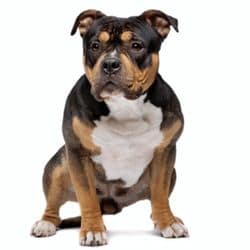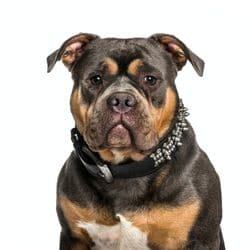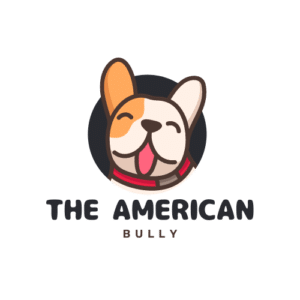Tri-color American bullies are a newer breed of American bullies becoming increasingly popular. They are a mix of three different bully breeds: the American Pit Bull Terrier, the American Bully, and the American Staffordshire Terrier. As their overall popularity grows, so does the need for information about these dogs.
This article will discuss the history of tri-color American bullies, their physical characteristics, and some of the myths that surround them.
What is a Tri-colored American Bully and What Makes it Rare?

You must be thinking that possessing tri-color fur patterns in animals and other breeds of dogs is not a new phenomenon. That is very true; however, tri-color fur patterns are pretty rare when it comes to bullies. In fact, out of the entire American bully population, only about 15% of dogs have this coloration.
The three breeds of dogs that make up the tri-color American bully – the American Pit Bull Terrier, the American Bully, and the American Staffordshire Terrier – only account for a small percentage of their breeds. So, when you put all three together, finding this specific coloration in a bully is very slim.
Tri-Color American Bullies: Rarity
While the tricolor coat pattern is a common feature of many dog breeds such as tri-color Pitbulls, an American Pitbull Terrier, Pitbull Terriers, and most Pitbull breeds – resulting from mixed breeds by general breeders, it is rare to glimpse a tri-colored American Bully.
This rare tricolor pattern features in bullies, a resulting output of many breeders who gambled in the gene pool of this mixed breed to pick on their stunning recessive gene and recessive nature.
Tricolored dogs in the American Bully breed family have to be a minimum of 75% American Bully and 25% of at least one other bully breed. To produce the right colors and markings, the makeup has to be just that – 25% of any different bully breed.
This is also the key reason tri-colored bullies are often mistaken for a Pitbull breed, as they share some common physical characteristics.
Physical Characteristics of Tri-Color American Bullies

After answering the question, “What is a tri-color American bully?” let’s look at their physical characteristics.
As mentioned earlier, tri-color American bullies are a mix of three different bully breeds: the American Pit Bull Terrier, the American Bully, and the American Staffordshire Terrier. They typically weigh anything between 50 and 70 pounds and standing in about 18 to 22 inches tall. Tri-color Bullies are one of the largest bully breeds.
Tri-color Bullies vs. Common American Bullies
Markings
Some of the most distinctive features of tri-color bullies are their markings. As mentioned earlier, they can come in any color combination, but tri-color is most common. They also have a black mask and black ears, which is not common in other bully breeds.
Weight and Height
Tri-color bullies are also typically more significant than other American bullies. They weigh anything in between 50 and 70 pounds on average and standing in about 18 to 22 inches tall.
Health and Temperament
As with any breed of dog, tri-color American bullies can vary in their health and temperament. However, they are typically considered a very healthy and friendly breed.
Coat Patter Variety of Tri-color American Bullies
The gene pool for tri-colored dogs and a three-colored coat pattern is a recessive gene, which is why they are so rare. It’s also the reason for different colors and markings in this coat pattern.
Black Tri-color American Bullies
The black tri-color bully is probably the most common tri-color pattern. They have a jet-black coat with tan markings on their muzzle, chest, and legs.
Blue Tri-Color American Bullies
The blue tri-color bully has a light blue coat with white markings on its muzzle, chest, and legs.
Red Tri-Color American Bullies
The red tri-color bully has a reddish-brown coat with white markings on its muzzle, chest, and legs.
Green Tri-Color American Bullies
The green tri-color bully has a light green coat with white markings on its muzzle, chest, and legs.
Champagne Tri-Color American Bullies
The champagne tri-color bully has a light beige coat with white markings on its muzzle, chest, and legs.
Fawn Tri-Color American Bullies
The fawn tri-color bully has a light brown coat with white markings on its muzzle, chest, and legs.
Sable Tri-Color American Bullies
The sable tri-color bully has a dark brown coat with black markings on its muzzle, chest, and legs.
Brindle Tri-Color American Bullies
The brindle pattern in the tri-color bully has a black and brown coat with white markings on its muzzle, chest, and legs. Brindle pattern is common in the American Pit Bull Terrier.
Tri Merle Tri-Color American Bullies
The tri merle tri-color bully has a black, white, and gray coat with blue eyes. This is the rarest of all the tri-color patterns.
Lilac Tri-Color American Bullies
The lilac tri-color bully has a light purple coat with white markings on its muzzle, chest, and legs. This is the rarest of all the tri-color patterns.
Chocolate Tri-Color American Bullies
The chocolate tri-color bully has a light brown coat with white markings on its muzzle, chest, and legs. This color is also standard in the American Pit Bull Terrier.
Piebald Tri-Color American Bullies
The piebald tri-color bully has a white coat with black and brown spots. This is the most common pattern in other breeds of dogs, but it’s rare in the American Bully.
American Bully coat colors on tricolor American Bullies may differ depending on the gene pool and breeding stock used. However, the tri-color coat pattern is always black, white, and tan.
Tri-Color American Bullies: The Science Behind Colors
The genes determine coat colors in tri-color American Bullies passed down from their parents. There are three primary colors in a tri-color coat pattern: black, white, and tan.
Black Allele and the Tricolor Coat Pattern
The black allele is the gene that codes for producing the black pigment melanin. This gene is dominant, which means that it will always be expressed in a tri-color American Bully coat.
The dominant black allele is a dominant gene, which is why black tri-color American bullies are so typical. If one parent has the black allele, all of their offspring will also have it.
White Allele and the Tricolor Coat Pattern
The white allele is the gene that codes for the production of the white pigment albinism. This gene is a recessive one, which means that it will only be expressed in a tri-color American Bully coat if both parents pass it down to their offspring.
Tan Points Allele and the Tricolor Coat Pattern
The tan point allele is a gene that codes for red and black pigment production. This allele is responsible for the tan markings on the tri-color bully’s coat. Tan point gene is recessive, so tri-color coat patterns are so rare. In the traditional tan points allele, the black pigment masks the red dye, so the black tri-color bully has a jet-black coat with tan markings.
However, there are also blue, and champagne tri-color bullies with the tan point allele. These colors are due to the production of white pigment rather than black pigment.
Creeping Tan Allele
Creeping tan is a dominant allele that causes the black pigment to slowly fade away, resulting in a lighter coat color over time. This allele is not common in the tri-color bully gene pool, but it can occur.
Merle Gene
The merle gene is also a possible factor in developing the tri-color coat pattern. Merles are usually heterozygous and have a marking pattern that is black and gray. They can also have blue eyes, so tri-color merles are so rare.
Expressing tan points in tri-color American Bullies
The tan point allele is a gene that codes for red and black pigment production. This allele is responsible for the tan markings on the tri-color bully’s coat. Tan point gene is recessive, so tri-color coat patterns are so rare. In the traditional tan points allele, the
Ghost Tan in Tri-color American Bullies
Tan terriers are typically a light brown with white markings on their chest, muzzle, and feet. However, a recessive gene can be passed down to tri-color American bullies that cause them to have a ghost tan coat. Ghost tans are very light brown with no markings.
Myths About Tri-Color American Bullies
Now that we have covered some of the basics about tri-color American bullies let’s discuss some of their myths.
1: Tri-color American bullies are automatically healthier than other color variations.
This is not true. Tri-color American bullies can have as many health problems as any other color variation.
2: Tri-color American bullies are automatically more aggressive than other color variations.
This is also not true. Tri-color American bullies can be just as friendly and docile as any other color variation.
3: Tri-color American bullies are automatically more intelligent than other color variations.
Again, this is not true. Tri-color American bullies can be just as dumb as any other color variation.
4: Tri-color American bullies are automatically more valuable than other color variations.
Once again, this is not true. Tri-color American bullies can be just as cheap as any other color variation.
5: Tri-color American bullies are automatically rare than other color variations.
This is true. Tri-color American bullies are much rarer than other color variations. They are so rare that many people have never even seen one before.
Tri-coat colors and a combination of the coat color in the dog world, and some pet owners may conceive the dog to be more valuable. However, this is not always the case.
Tri-Color American Bullies: Average Price Ranges
Tri-color pitbull puppies and their intricate coat color may be why some people think they are more valuable than other colors of pit bulls. Tri-color American bullies are not always more expensive than different colors. The average price range for tri-color American bully puppies is $500-$2000. However, some breeders out there may charge more or less all depending on the dog’s bloodline.
In Conclusion
Coat color in tricolor American Bullies and other dogs is a genetic trait passed down from parents to their offspring. This allele can be expressed in different ways, so there are so many color variations in the bully breed.
While tri-color American bullies are not always healthier than other color variations, they are unique and beautiful dogs that deserve to be loved and appreciated.
May this article have helped you learn more about the tri-color American bully and dispel some of the myths surrounding them. Thank you for reading!
